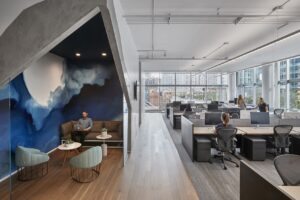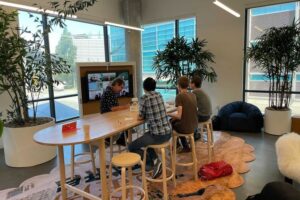As work evolves, it’s crucial to understand the new paradigms shaping our workplaces. Welcome back to our Unworking Weekly mini-series, inspired by new book “Unworking: The Reinvention of the Modern Office” by Philip Ross & Jeremy Myerson.
Over the past eleven weeks, we have explored the themes of each chapter, offering insights into the book’s vision for the future of work and the workplace. Offices have been integral to society for the past century, influencing everything from city architecture to daily routines. However, the pandemic triggered a re-evaluation of the office’s role, promoting a shift away from outdated practices. As we enter the eleventh week of our series, we delve into Chapter 12, which examines the theme of Hybridity, a concept that is increasingly relevant in today’s evolving work environments.
This week’s blog focuses on Chapter 12: Hybridity. The hybrid model of work blends physical and digital spaces, integrating on-site and remote working experiences. This chapter explores how hybridity is reshaping the modern office, from flexible schedules to blended technologies that bridge the gap between different modes of working. As organisations adopt hybrid strategies, they are navigating new ways to ensure that collaboration, productivity, and workplace culture thrive in both physical and digital realms.
Defining Hybridity in the Workplace
Hybridity, in the context of work and workplace, refers to the integration of physical and digital environments, allowing employees the flexibility to work both in-office and remotely. This approach combines the best aspects of both environments, ensuring that the benefits of in-person collaboration coexist with the flexibility and autonomy of remote work.
Flexibility and Autonomy
A major benefit of hybridity is the flexibility it offers employees, allowing them to balance personal and professional commitments while maintaining productivity. By decentralising the traditional office model, hybrid work allows for more control over when and where tasks are completed. This not only supports well-being but also encourages a results-oriented approach to work, where outcomes are prioritised over physical presence.
Slack’s headquarters in San Francisco is a great example of an office designed with hybridity in mind. Their workplace strategy allows employees to choose whether they work remotely or on-site, depending on the nature of the task. The office itself is designed with hot-desking and collaboration zones, ensuring that when employees are on-site, they have access to the tools and spaces they need to collaborate effectively. This flexibility fosters an environment where employees can enjoy the benefits of both remote and in-person work.

Technology as the Connector
Technology is the backbone of hybridity, enabling seamless transitions between remote and in-office work. Cloud-based platforms like Microsoft 365 and Google Workspace allow employees to access files and collaborate in real-time from any location, ensuring that work progresses smoothly regardless of physical distance. Tools like Zoom, Microsoft Teams, and Slack facilitate virtual meetings and instant communication, bridging the gap between remote and on-site workers.
Advanced video conferencing systems and virtual collaboration tools mimic the spontaneity and interaction of traditional office environments. Features like screen sharing, virtual whiteboards, and real-time chat keep teams connected and productive. This level of connectivity ensures that collaboration, communication, and productivity are not compromised, making technology a critical enabler of the hybrid workplace.
HubSpot, one of the leaders in inbound marketing software, has embraced a hybrid work model supported by technology. The company has integrated various collaborative tools like the aforementioned Slack, Zoom, and Google Workspace to enable seamless communication across its global teams. Additionally, HubSpot’s offices are equipped with cutting-edge video conferencing setups that ensure remote workers feel as engaged as those on-site. Their strategy has led to higher employee satisfaction, with staff benefiting from the flexibility of hybrid work while staying connected through digital platforms.

Redefining Workplace Culture
One of the biggest challenges—and opportunities—of hybridity is the redefinition of workplace culture. With teams working in different physical spaces, organisations need to cultivate a sense of community that transcends the office walls. This requires intentional efforts to build strong connections, foster inclusion, and ensure that all employees, whether remote or on-site, feel engaged and valued.
Dropbox, with its “Virtual First” policy, is an excellent example of a company that incorporates hybrid social activities to maintain a connected culture. While Dropbox employees work remotely most of the time, the company has created “Dropbox Studios” in major cities for occasional in-person collaboration and social interactions. To bridge the gap between remote and office workers, Dropbox hosts hybrid events such as virtual happy hours, trivia nights, and remote-friendly team-building exercises.
These activities are designed to ensure that both in-office and remote employees can participate equally, fostering camaraderie and maintaining a strong company culture regardless of physical location.

As workplaces continue to evolve, hybridity stands out as a model that offers flexibility, fosters productivity, and redefines workplace culture. From flexible schedules and remote work options to advanced technological tools that support seamless collaboration, the hybrid model represents a significant shift in how we think about work and the workplace. In Unworking: The Reinvention of the Modern Office, authors Philip Ross and Jeremy Myerson explore these themes in detail, offering insights into how the hybrid model is shaping the future of work.
By understanding the principles of hybridity, organisations can create dynamic environments that not only meet the needs of a modern workforce but also support innovation, collaboration, and well-being across both physical and digital realms.
Grab your copy of Unworking from Amazon here.

